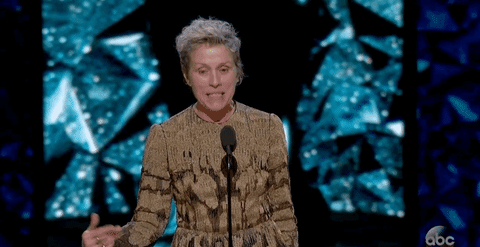"I have two words to leave with you tonight, ladies and gentlemen: inclusion rider."
It was with those seemingly simple words that an electrified Frances McDormand ended her lively Oscar acceptance speech last Sunday after taking home the Academy Award for Best Actress (the second of her career, by the way). Sharing more than a bit of DNA with the firebrand she portrays in Three Billboards Outside Ebbing, Missouri, McDormand's short but pointed speech brought a vibrancy to an evening that addressed the #MeToo movement but remained overall, a staid black-tie affair.
But McDormand's speech may have left many viewers wondering what exactly is an "inclusion rider." In short, an inclusion rider is just one of many tools artists in Hollywood are beginning to employ to make film and television sets a more equal and diverse place. When an actor or director signs on to a film she or he can negotiate a rider, or additional provisions, that the studio must abide to. These riders can include anything from the size of a star's trailer to the food at craft services. An inclusion rider is a stipulation that the cast and/or crew of the film reflects an equal and diverse workplace in regards to gender, race, sexual orientation and/or disability.
The concept of an inclusion rider was originated by Stacy Smith in a 2016 TED talk entitled "The Data Behind Hollywood's Sexism" In her speech, Smith laid out some startling statistics. "Across the top 100 films of just last year, 48 films didn't feature one black or African-American speaking character, not one," explained Smith. "70 films were devoid of Asian or Asian-American speaking characters that were girls or women. None. Eighty-four films didn't feature one female character that had a disability. And 93 were devoid of lesbian, bisexual or transgender female speaking characters. This is not underrepresentation. This is erasure, and I call this the epidemic of invisibility."
Smith suggests that one catalyst for change could be A-List celebrities. "What if those A-listers simply added an equity clause or an inclusion rider into their contract?" asks Smith. "An equity rider by an A-lister in their contract can stipulate that those roles reflect the world in which we actually live."
If ticket sales are any indication, audiences are welcoming diversity both on screen and in the director's chair. In 2017, Wonder Woman, starring Gal Godot and directed by Patty Jenkins, grossed an astounding $412 million domestically, making it the most financially successful female directed film of all time. Recently, Black Panther and Get Out also proved that films created by and starring African Americans can be box office gold. This Friday sees the release of Disney's A Wrinkle in Time, directed by Ava Duvernay, an African American woman and it features a diverse cast that includes Oprah Winfrey, Mindy Kaling, and a teenage African American female lead.
While these recent trends show more than a glimmer of hope, Hollywood still has a long way to go. In 2017, only 8% of the 100 top grossing films were directed by women despite the fact that women make up 52% of the movie going audience. Perhaps if Hollywood begins to heed the words of Frances McDormand, the "silver screen" will begin to get a lot more colorful.




